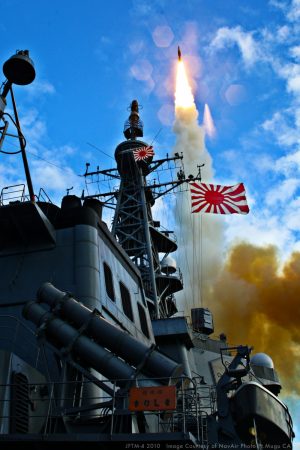Japan has condemned North Korea after a string of ballistic missiles launched this month landed in the Sea of Japan, known as the East Sea in Korea. On Friday afternoon North Korea is believed to have fired two short-range ballistic missiles from North Pyongan province, which flew approximately 400 kilometers to the east. The missiles are believed to have fallen into the ocean outside Japan’s Exclusive Economic Zone (EEZ). The firings marked the third and fourth North Korean missile launched so far this year, highlighting an unprecedented succession of missile tests as the Kim Jong Un regime pushes forward with nuclear and missile development.
The two short-range ballistic missiles are believed to have flown at a lower altitude and a speed of Mach 10, which is 10 times the speed of sound. According to South Korea, the missiles were more technologically “advanced” than the missile launched on January 5 but reached the same speed of the missile launched on January 11. According to North Korea, both the January 5 and January 11 tests involved “hypersonic” missiles, although that claim has been disputed. It’s unclear whether North Korea’s newly tested missiles are in an early phase, in the middle of their process of development, or nearing completion.
The rapid pace of missile launches raises concerns about Japan’s current defense capacity and whether it can depend on the U.S. to intercept a possible missile attack from North Korea.
Foreign Minister Hayashi Yoshimasa strongly condemned the latest launch as a violation of U.N. Security Council resolutions. Meanwhile, Defense Minister Kishi Nobuo said Japan will continue to monitor the situation. Kishi stated, “We are determined to protect the lives of our citizens and our peaceful lifestyle in close cooperation with the U.S., South Korea and other countries.” He also instructed the defense ministry and Self Defense Forces (SDF) to do their utmost to collect and analyze information in close cooperation with the United States and other countries.
Prime Minister Kishida Fumio expressed “deep regret” over the continued missile launches and lodged a formal protest with North Korea. He stressed they would consider all means of response, including the ability to attack enemy bases, and will work to strengthen Japan’s defense capabilities. There were no reports of damage to aircraft or ships.
Security experts and Japan’s SDF members have voiced doubts over Japan’s ability to attack an enemy base or prevent a missile attack considering both China and North Korea have more than 1,000 ballistic missiles, as well as mobile launchers, in their arsenal. The mobilization of Japan and the United States’ reconnaissance satellites and high-altitude surveillance aircraft would not be enough to detect all potential attacks ahead of time.
On June 22 the government abandoned the planned construction of two land-based sites for the missile defense system Aegis Ashore due to escalating costs, which were estimated to have run over $8 billion. The Aegis Ashore system is considered the only reliable defense as it has the ability to automatically intercept incoming ballistic missiles. The government has opted instead to pursue the installation of the land-based system on a maritime destroyer – an unprecedented project on which the design and construction costs are yet to be determined. The string of missile launches by North Korea may spark conversations on requesting a budget for a sea-based Aegis missile defense system, which remains in limbo. Japan does have four Aegis-equipped destroyers, which use the ship-based version of the system.
A Chinese Foreign Ministry spokesperson urged countries not to make hasty decisions or to overreact to the launches. Beijing also called on North Korea, the U.S., and others to resume dialogue.
Meanwhile, the United States condemned the missile launch as a threat to peace in the region and called on North Korea to stop provocations. The U.S. Indo-Pacific Command responded by saying, “The U.S. commitment to the defense of Japan and South Korea is unwavering,” but added that it “remained committed to a diplomatic approach.”
Japan and North Korean relations are in a state of breakdown and North Korea-U.S. talks on denuclearization have stalled since the collapse of the 2019 summit in Hanoi. An important factor for the Kishida administration will be to assess North Korea’s true nuclear and military strength before setting the tone of its diplomatic position on North Korea.
North Korea has launched 40 missiles since May 2019, with the aim of improving its missile technology. But it is also likely to be in reaction to new U.S. sanctions, with North Korea issuing a statement condemning the U.S. sanctions on six North Korean individuals involved in the regime’s weapons development. They warned that if the U.S. takes a confrontational stance North Korea will be forced to react even more strongly.

































